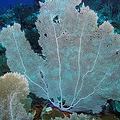 根據一項針對加勒比海沿岸13個國家、共322個地點的新研究,該區域珊瑚礁受到人類活動影響而遭破壞,包括海岸開發、漁業活動、污染和農地利用。
根據一項針對加勒比海沿岸13個國家、共322個地點的新研究,該區域珊瑚礁受到人類活動影響而遭破壞,包括海岸開發、漁業活動、污染和農地利用。
「如果這些不被認為是威脅,也沒有馬上控制,那麼珊瑚礁的持續破壞就快要到無法復原的地步了,」這項研究的作者、加拿大哈利法克斯市達豪司大學的莫拉(Camilo Mora)說,「特別是在加勒比海域,這些損失正危及從珊瑚到鯊魚的大量物種,也使漁業、觀光和海岸防護總值超過40億美元的收益陷入困境。」
「加勒比海珊瑚礁的未來,和它們能提供給成長中人口的利益,取決於這地區的國家多快開始努力解決人類帶來的威脅,」莫拉說。
這項研究發表在《倫敦皇家學會會報B》(Proceedings of the Royal Society of London B)的最新議題中,內容含有一組包含人口密度、海岸開發、農地利用和環境與生態的社經資料庫。這些數據涵蓋了溫度、颶風、生產率、珊瑚疾病和豐富的珊瑚資源等資訊。
經由統計分析,莫拉的研究顯示岀珊瑚礁附近的居民數量是導致珊瑚死亡、魚數量減少和大海藻大量增加的主要因素。
肉眼可見的海藻通常是指大海藻和海草,是世界各地海岸水域的常見大型植物。而多餘的大海藻死亡後分解腐爛,會降低水中的溶氧量。
莫拉比較分析了人類造成的各種衝擊,發現土地開墾和在珊瑚礁海岸使用化學農藥,是導致加勒比海大海藻增加的主因。
Coral reefs in the Caribbean are being degraded by human activities - coastal development, fishing, pollution, and agricultural land use - according to a new study of 322 sites across 13 countries throughout the region.
"The continuing degradation of coral reefs may be soon beyond repair, if threats are not identified and rapidly controlled," said author Camilo Mora at Dalhousie University, Halifax. "In the Caribbean alone, these losses are endangering a large number of species, from corals to sharks, and jeopardizing over four billion dollars in services worth from fisheries, tourism and coastal protection."
"The future of coral reefs in the Caribbean and the services they provide to a growing human population depend on how soon countries in the region become seriously committed to regulating human threats," Mora said.
Published in the current issue of the "Proceedings of the Royal Society of London B," the study includes a comprehensive set of socioeconomic databases on human population density, coastal development, agricultural land use as well as environmental and ecological databases. The data cover temperature, hurricanes, productivity, coral diseases and richness of corals.
Through statistical analysis, Mora‘s study shows that the number of people living near coral reefs is the main driver of the mortality of corals, loss of fish biomass and increases in macroalgae abundance.
Macroscopic algae, commonly referred to as macroalgae or seaweeds, are large plant like structures commonly found in coastal waters worldwide. An excess of macroalgae can decrease oxygen levels in the water when the algae die and decompose.
Mora's comparative analysis of different human impacts revealed that the area of cultivated land, with its discharges of agricultural chemicals to coral reefs, was the main driver of increases in macroalgae in the Caribbean.
全文及圖片詳見:ENS






